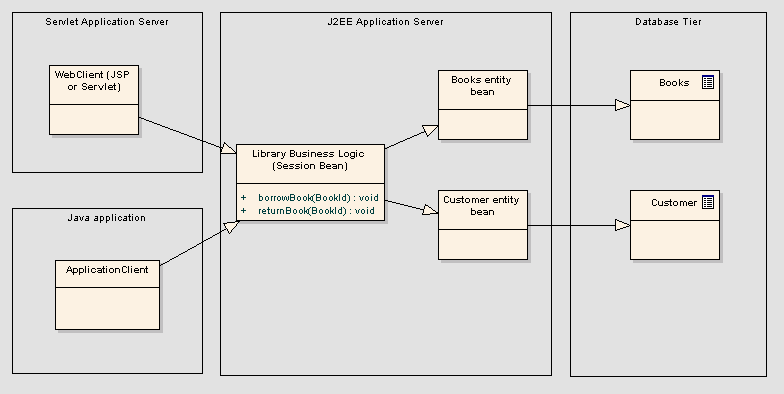Java Encyclopaedia
First pages of an encyclopedia including javas common abbreviations and technologies. We try to explain short and easily to understand the terms of the java world.
General
Author:
Sebastian Hennebrüder
www.laliluna.de/tutorials.htmlDate:
November, 13th 2004
EJB = Enterprise Java Beans
This is a technology from Sun to develop multi tier applications. A EJB is a special kind of class. There are three major types of EJBs.

Entity Beans
They can be used to map a entry in a database table to a class. (Object Relational Mapping) Instead of using result Sets from a database query you work with a class. The application server provides the functionality to load, update or delete the values of a class instance to the database.
Session Beans
You can implement the functionality of your application with session beans. The functionality or business logic is not implemented on the client but on the application server. A client can be for example a web client.
Message Driven Beans
Message beans provide functionality to implement messaging in your business logic. When you want to send a message to one or more recipients to start another business logic, you can use message beans.
A Shop application could send a order message to the Warehouse management. Once the warehouse management software is started, it receives the orders from the shop application.
Hibernate
Open source persistence technology. Probably the most advanced open source solution to map classes to database tables. It is an alternative to Entity beans (EJB).
J2SE
Java 2 Platform, Standard Edition (J2SE), is a development environment and at the same time the development language java. You need this to develop java even you use other environments like eclipse/MyEclipse.
J2EE
Java 2 Platform, Enterprise Edition (J2EE) is a standard to implement multitier server centric applications. It uses Enterprise Java Beans to implement business logic, messaging and persistence to databases.
There is a wide choice of application server supporting J2EE.
JSP
JSP are HTML files that include Java code. They are compiled to the same as Servlets. You use JSP when developing dynamic Web Applications.
Object Relational Mapping
Object oriented development normally has to deal with not object oriented databases. Instead of using the result set of a table directly, you can copy a row of a result set to a class instance or the complete result set to an array of classes.
This is called object relational mapping. You do not have to implement this for yourself but you can use Entity EJB or Hibernate to do this.
Persistence
In an average application: What do you think how much percent of the queries do only create/update/delete an entry in a table?
Do you think that it should be your job to write these tedious statements? Persistence technologies are exactly what you need.
Persistence = write data to somewhere where it can stay for ever, normally a database
Based on a class and a description file (often in xml) of the table mapping, the persistence technology knows from which table it has to read the data.
Servlets
Java file that outputs data in any kind for formats (html, xml, pdf, ...). This is normally used for web development together with JSPs.
Web development
Java offers object oriented web development to you. Using JSPs and Servlets for dialogs and java classes for functionality (business logic). You need a servlet engine like Tomcat when you want to use JSP and Servlets. When you are interested in multitier development using J2EE you will also need a application server (eg. Jboss). Jboss does integrate Tomcat.
There are very nice frameworks which provides functionality like internationalization, separation of dialogs and business logic, error handling and validation of forms.
When you want to learn web development start with JSP and Servlets and then go on to use Struts or Cocoon.